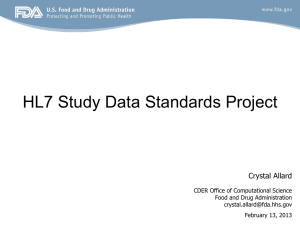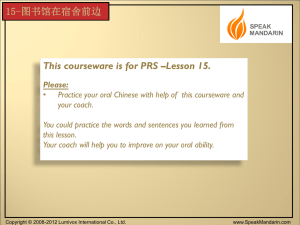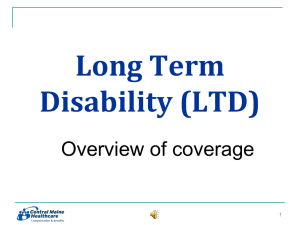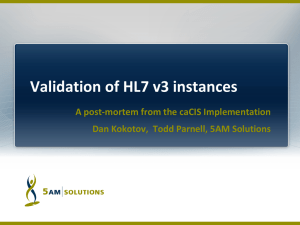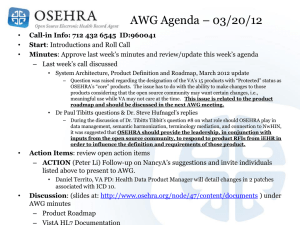Modelling Clinical Information Using UML
advertisement
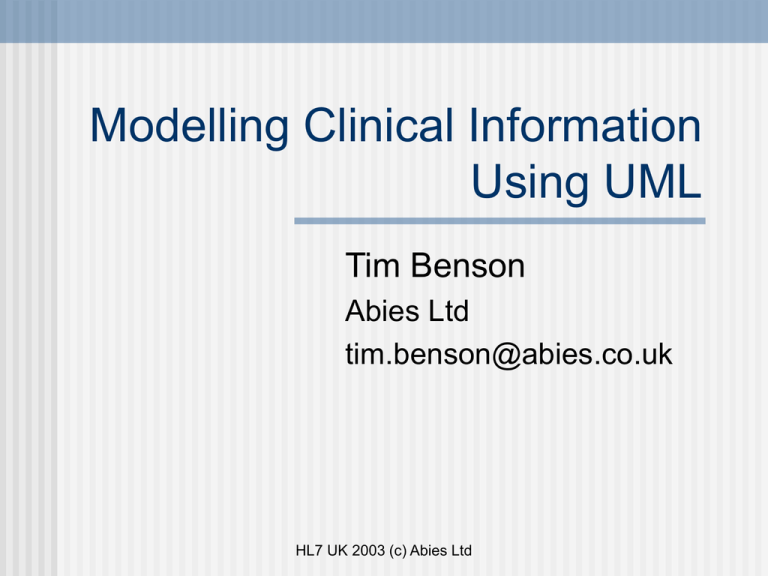
Modelling Clinical Information Using UML Tim Benson Abies Ltd tim.benson@abies.co.uk HL7 UK 2003 (c) Abies Ltd Overview Show how UML class diagrams add value to the HL7 v3 development process Focus is on detailed Requirements specification and data element definitions (Glossary) HL7 UK 2003 (c) Abies Ltd The Problem HL7 v3 is a foreign language to clinicians HL7 RMIMs are specialised tools for developing healthcare message XML schemas Not suited for capturing requirements Formal class names based on structural attributes Small number of common attribute names based on the RIM Pre-defined Data Types and Vocabulary HL7 UK 2003 (c) Abies Ltd The Solution Specify message requirements in detail using: Visual data modelling (UML class diagrams) Glossary - detailed definition of every data item in context Then map to HL7 RMIM HL7 UK 2003 (c) Abies Ltd Iterative Development HL7 is concerned with the whole process - not just drafting documents HL7 UK 2003 (c) Abies Ltd Phases HL7 UK 2003 (c) Abies Ltd HL7 Message Development Framework (MDF) 1999 Application Role Trigger Event RIM Instantiate Storyboard Sender Receiver D-MIM Restrict Triggers References Interaction Example R-MIM Restrict HMD Restrict Storyboard Example Content HL7 UK 2003 (c) Abies Ltd Message Type What is a model? Two sorts of model: To describe the real world • Can never be “right” To design and build things • Specification Always a simplification HL7 UK 2003 (c) Abies Ltd Models and Diagrams Model is all information in a project Model may include Glossary Model is much more than a collection of diagrams Each diagram is just one view on a Model Most models contain dozens of diagrams HL7 UK 2003 (c) Abies Ltd Real World Models Abstraction Abstract model Enterprise model Situation model Scope HL7 UK 2003 (c) Abies Ltd Specification Models Abstraction Reference model Logical model Implementation model Scope HL7 UK 2003 (c) Abies Ltd OMG MOF (meta object facility) M3 meta-metamodel M2 meta-model, meta-metadata (languages) M1 model, meta-data (standards) M0 data (systems) HL7 UK 2003 (c) Abies Ltd Matrix Base standards (M3) HL7 architecture (M2) UML Vocabulary Specification Requirement (M1) Specification Use (M0) XML RIM DataTypes RMIM HMD XML Schema Operation HL7 UK 2003 (c) Abies Ltd Testing UML Unified Modelling Language Mandated in e-GIF OMG standard UML 1.1 1997 Version 1.4 2000 UML 2.0 2003 MDA Model Driven Architecture XMI (XML Metadata Interchange) HL7 UK 2003 (c) Abies Ltd UML Diagrams 12 Diagram Types Class diagram Activity diagram Sequence diagram State-chart diagram Use case diagram HL7 UK 2003 (c) Abies Ltd UML Notation Classes and Attributes Association (Composition and Aggregation) Specialisation Multiplicities (optionality) HL7 UK 2003 (c) Abies Ltd Composition Composition includes 1..* S tatement HL7 UK 2003 (c) Abies Ltd Aggregation Folder 0..* Compos ition inc ludes 1..* S tatement HL7 UK 2003 (c) Abies Ltd Specialisation Folder Document 0..* Composition E ncounterRec ord includes 1..* S tatement HL7 UK 2003 (c) Abies Ltd Navigation S ubjec tOfCare c onc erns Compos ition c reated by HealthCareP arty HL7 UK 2003 (c) Abies Ltd Healthcare Party ComputerSystem HealthCareP arty P erson HealthCareOrganisation HealthCareP rofessional HL7 UK 2003 (c) Abies Ltd Attributes HealthCareP arty P erson +personName ComputerSys tem HealthCareOrganisation HealthCareP rofessional +organisationName +registrationID +organisationID +hcpT ype +organisationT ype HL7 UK 2003 (c) Abies Ltd Patients and Healthcare Parties E lectronicAdd ress 0..* has P arty S ubjectOfCare has 0..* A ddress P erson HealthCareP arty RelatedPerso n is 0..* has 1..* ComputerSystem HealthCareOrganisation at HealthCareP rofessional HL7 UK 2003 (c) Abies Ltd under care of P atient Healthcare Document Structure Composition concerns is 1..* S ubjectOfCare P atient written by P erson A uthor includes HealthCareP rofessional HealthCareDocument 1..* S tatement may have A ddressee HealthCareP arty at 0..* CopyDestination ComputerSys tem HL7 UK 2003 (c) Abies Ltd HealthCareOrganisation Clinical Information Complexes Composition includes 1..* S tatement 0..* ClinicalInfoComplex contains may have 1..* ClinicalInfoItem HL7 UK 2003 (c) Abies Ltd Headings and Problem Lists Composition HealthTo pic includes is label fo r 1..* 0..* S tatement HL7 UK 2003 (c) Abies Ltd Clinical Statements Compos ition is label for HealthTopic inc ludes 1..* S tatement 0..* 0..* Clinic alInfoCo mplex 1 c ontains 1..* Clinic alInfoItem HL7 UK 2003 (c) Abies Ltd may have Clinical Information Items ClinicalInfoItem P lanItem P rocedure RequestItem Observation refers to MedicationItem refers to A nalysableObject S pecimen S tudyP roduct HL7 UK 2003 (c) Abies Ltd A dminItem Conclusions Health Information is complex, but not impossibly complex This paper has illustrated a few high level patterns UML and XML provide complementary sets of tools HL7 UK 2003 (c) Abies Ltd
